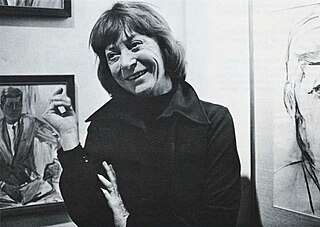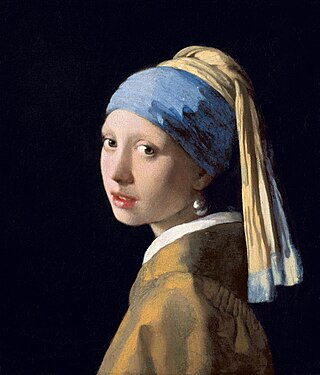Jerome Witkin | |
|---|---|
| Born | September 13, 1939 |
| Nationality | American |
| Education | The High School of Music & Art Skowhegan School of Painting and Sculpture Cooper Union Berlin Academy University of Pennsylvania |
| Known for | Painting |
| Movement | Social realism |
| Children | Christian Witkin |
| Family | (twin brother) Joel Peter Witkin |
| Awards | Pulitzer Traveling Fellowship Guggenheim Fellowship |
Jerome Witkin (born September 13, 1939) is an American figurative artist whose paintings deal with political, social and cultural themes, [1] along with serious portraiture that melds the sitter's social position with a speaking likeness that reveals inner character. Witkin has been succinctly characterized as "a virtuoso figurative painter whose work mixes elements of the old masters, social realism and Abstract Expressionism ..." [2]
Witkin was born in Brooklyn, New York, the twin brother of photographer Joel Peter Witkin. [1] Recognized as a prodigious talent, at fourteen he entered The High School of Music & Art in New York, and subsequently studied at the Skowhegan School of Painting and Sculpture, Cooper Union, the Berlin Academy, and the University of Pennsylvania. A Pulitzer Traveling Fellowship enabled him to travel, study and further develop in Europe.
After his return to the United States, Witkin received a Guggenheim Fellowship, began exhibiting at galleries in New York and joined the faculty of the Maryland Institute College of Art. He later taught at the Manchester College of Art in England, and then the Moore College of Art. In 1971, he became a professor of art at Syracuse University. [3]
Witkin's work can be thought of as an interrelationship of three bold explorations:
While his paintings reference the work of the old masters, social realism, and abstract expressionism, Witkin, in a self-deprecating manner, refers to himself as a "cornball humanist". [2] In a fuller explanation of his motivation, Witkin has emphasized, "If this society continues to the next two thousand years, people will be looking at the twentieth century and saying, 'What did artists do about the strange goings-on?'" [4]
Witkin's work is included in the permanent collections of the Metropolitan Museum of Art, the Uffizi, the Cleveland Museum of Art, and the Hirshhorn Museum. [1] [5]
Witkin is the father of photographer Christian Witkin. [6]

The history of painting reaches back in time to artifacts and artwork created by pre-historic artists, and spans all cultures. It represents a continuous, though periodically disrupted, tradition from Antiquity. Across cultures, continents, and millennia, the history of painting consists of an ongoing river of creativity that continues into the 21st century. Until the early 20th century it relied primarily on representational, religious and classical motifs, after which time more purely abstract and conceptual approaches gained favor.
Abstract expressionism is a post–World War II art movement in American painting, developed in New York City in the 1940s. It was the first specifically American movement to achieve international influence and put New York at the center of the Western art world, a role formerly filled by Paris.

Modern art includes artistic work produced during the period extending roughly from the 1860s to the 1970s, and denotes the styles and philosophies of the art produced during that era. The term is usually associated with art in which the traditions of the past have been thrown aside in a spirit of experimentation. Modern artists experimented with new ways of seeing and with fresh ideas about the nature of materials and functions of art. A tendency away from the narrative, which was characteristic for the traditional arts, toward abstraction is characteristic of much modern art. More recent artistic production is often called contemporary art or postmodern art.

Visual art of the United States or American art is visual art made in the United States or by U.S. artists. Before colonization, there were many flourishing traditions of Native American art, and where the Spanish colonized Spanish Colonial architecture and the accompanying styles in other media were quickly in place. Early colonial art on the East Coast initially relied on artists from Europe, with John White the earliest example. In the late 18th and early 19th centuries, artists primarily painted portraits, and some landscapes in a style based mainly on English painting. Furniture-makers imitating English styles and similar craftsmen were also established in the major cities, but in the English colonies, locally made pottery remained resolutely utilitarian until the 19th century, with fancy products imported.

Elaine Marie Catherine de Kooning was an Abstract Expressionist and Figurative Expressionist painter in the post-World War II era. She wrote extensively on the art of the period and was an editorial associate for Art News magazine.

Color field painting is a style of abstract painting that emerged in New York City during the 1940s and 1950s. It was inspired by European modernism and closely related to abstract expressionism, while many of its notable early proponents were among the pioneering abstract expressionists. Color field is characterized primarily by large fields of flat, solid color spread across or stained into the canvas creating areas of unbroken surface and a flat picture plane. The movement places less emphasis on gesture, brushstrokes and action in favor of an overall consistency of form and process. In color field painting "color is freed from objective context and becomes the subject in itself."

Joel-Peter Witkin is an American photographer who lives in Albuquerque, New Mexico. His work often deals with themes such as death, corpses, often featuring ornately decorated photographic models, including people with dwarfism, transgender and intersex persons, as well as people living with a range of physical features. Witkin is often praised for presenting these figures in poses which celebrate and honor their physiques in an elevated, artistic manner. Witkin's complex tableaux vivants often recall religious episodes or classical paintings.
Nicholas Marsicano was an American painter and teacher of the New York School. His work was primarily based on the female figure.

The history of Western painting represents a continuous, though disrupted, tradition from antiquity until the present time. Until the mid-19th century it was primarily concerned with representational and Classical modes of production, after which time more modern, abstract and conceptual forms gained favor.

Augustus Vincent Tack (1870–1949) was an American painter of portraits, landscapes and abstractions.
Gregorio Prestopino (1907–1984) was an American artist. According to the art historian Irma B. Jaffe, he was "one of the major American painters who refused to reject the image, [and] has devoted his career to depicting the human condition with a warmth tempered only by honesty".

New York Figurative Expressionism is a visual arts movement and a branch of American Figurative Expressionism. Though the movement dates to the 1930s, it was not formally classified as "figurative expressionism" until the term arose as a counter-distinction to the New York-based postwar movement known as Abstract Expressionism.

Norman Wilfred Lewis was an American painter, scholar, and teacher. Lewis, who was African-American and of Bermudian descent, was associated with abstract expressionism, and used representational strategies to focus on black urban life and his community's struggles.

20th-century Western painting begins with the heritage of late-19th-century painters Vincent van Gogh, Paul Cézanne, Paul Gauguin, Georges Seurat, Henri de Toulouse-Lautrec, and others who were essential for the development of modern art. At the beginning of the 20th century, Henri Matisse and several other young artists including the pre-cubist Georges Braque, André Derain, Raoul Dufy and Maurice de Vlaminck, revolutionized the Paris art world with "wild", multi-colored, expressive landscapes and figure paintings that the critics called Fauvism. Matisse's second version of The Dance signified a key point in his career and in the development of modern painting. It reflected Matisse's incipient fascination with primitive art: the intense warm color of the figures against the cool blue-green background and the rhythmical succession of the dancing nudes convey the feelings of emotional liberation and hedonism.

American Figurative Expressionism is a 20th-century visual art style or movement that first took hold in Boston, and later spread throughout the United States. Critics dating back to the origins of Expressionism have often found it hard to define. One description, however, classifies it as a Humanist philosophy, since it's human-centered and rationalist. Its formal approach to the handling of paint and space is often considered a defining feature, too, as is its radical, rather than reactionary, commitment to the figure.
Alfred Leslie was an American painter and filmmaker. He first achieved success as an Abstract Expressionist painter, but changed course in the early 1960s and became a painter of realistic figurative paintings.
Walter Kuhlman (1918–2009) was a 20th-century American painter and printmaker. In the late 1940s and 1950s, he was a core member of the San Francisco School of Abstract Expressionism. He later worked in a representational style related to American Figurative Expressionism.
Walter Henry "Jack" Beal Jr. was an American realist painter.
Boston Expressionism is an arts movement marked by emotional directness, dark humor, social and spiritual themes, and a tendency toward figuration strong enough that Boston Figurative Expressionism is sometimes used as an alternate term to distinguish it from abstract expressionism, with which it overlapped.
Ben Wilson was an American artist known for his early, expressionistic paintings from the mid-1930s to the mid-1950s and his subsequent non-objective paintings, a personal synthesis of abstract expressionism and constructivism. He is generally considered a second-generation abstract expressionist.